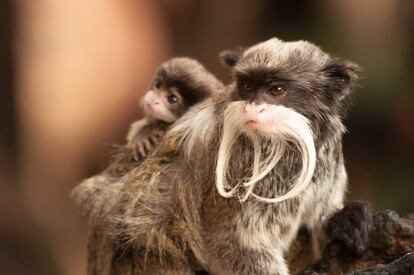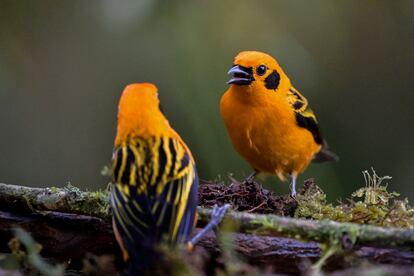Does it make sense to talk about monogamy in nature?
Animals employ a variety of methods when it comes to mating, leading scientists to question the idea of mammals and birds remaining faithful to one partner

Many relationships are considered monogamous, especially in Western societies, but not all couples identify with the term. Etymologically, “monogamy” is a Greek word that refers to the act of marrying only once in a lifetime, but in practice, there is a great deal of confusion about what the term means and how to use it properly. This is even the case in scientific fields that study the social behavior of animals.
Let’s imagine that two voles live together their entire lives and are united by an emotional bond, but they have sexual relations with other voles. Or two solitary fish reproduce only once in their lives and only with the same individual. Should we consider these animals monogamous? What exactly defines monogamy?
For much of the 20th century, the scientific community assumed that most birds were monogamous since 90% of species form pairs. Females were assumed to be faithful. Scientists documented only occasional cases of forced copulation in which another male visited the nest of a paired female and forced her to have sex. This behavior fits the widely accepted hypothesis of parental investment. According to the theory’s proponents, females are more selective than males when having sex because they have to invest more energy in reproducing. Thus, scientists believed that female birds were passive and that it fell to males to actively seek sex.

Such ideas aligned with contemporary concepts of women. For example, in Desmond Morris’s influential 1967 book The Naked Ape, he portrayed the woman in hunter-gatherer societies as a monogamous being who happily waited for her man to return from the hunt to satisfy her sexually. In fact, Morris argued that the female orgasm first emerged to strengthen the bonds between couples.
Soon, dissenting voices questioned the idea of the submissive and monogamous woman, especially feminist scientists such as Sara Hardy and Patricia Gowaty. The latter was studying bluebirds (Sialia sialis), which were considered to be monogamous. In an interview, Gowaty recounts that early in her career, in the 1980s, she noticed that the females were actively unfaithful. “Females will get up in the middle of the night and fly a mile away,” she noted. When she informed her colleagues, they refused to accept what she was telling them; that was not how female birds were supposed to behave. Nevertheless, she eventually managed to get her research findings acknowledged; in 1984, she published the first paper to question the sexual passivity of female birds.
Today, we know that infidelity is a daily occurrence in avian pairs, by both males and females. Indeed, 11% of offspring are “the result of extra-pair paternity,” according to a 2002 study. There are several hypotheses that attempt to explain the evolutionary advantages of a female breeding with a male that is not her usual mate. One theory is that the behavior allows the female to maximize genetic diversity among her offspring. Another hypothesis is that it allows her to take advantage of the opportunity to breed with a male that may be better endowed than her mate. Whatever the reason, sexual exclusivity in animals is so rare that scientists have finally begun to specify that they’re referring to social monogamy, which does not necessarily imply sexual monogamy.
Even so, it is not just a matter of differentiating between social and sexual monogamy. The reason that there is so much confusion in this regard is because monogamy is not just a single characteristic; rather, there are a variety of ways to be monogamous. In some species, the couple is equally involved in caring for the offspring, while in others the mates have unequal roles; some always live together and others only intermittently. Some mate for life, but others do so for only one season; some show jealousy and others do not; most show affection, but others only procreate.

Even among primates there are disparate cases. For instance, the Masoala forked-eared lemur (Phaner furcifer) is a nocturnal primate from Madagascar; these animals form pairs and live together in the same area. Males actively defend the territory. The pairs are very stable and usually last for over three years. However, males and females rarely have sex; when they do, they show very little interest in each other or, worse, the encounters are not friendly. Females are the dominant ones and often fight for food, while males avoid conflict. Their relationship is limited to distant vocalizations and sexual encounters. It’s a coupling in which there’s no emotional bond.
That’s vastly different from the monogamy of marmosets, in which the affective bond is so strong that the animals have been suggested as a model for studying the sentimental bonds between humans. They tend to stay together to eat and move around, attack individuals that may endanger their bond, suffer stress when they’re separated, maintain sexual exclusivity, raise their offspring together and even sit with their tails intertwined. Marmosets are one of the very few species that combine many different aspects of monogamy.
As with animals, monogamy varies among humans. Some people build their lives together but have sex with other people. Others have their children with the same individual, but fall in love with more than one person at a time. Some people raise their offspring together but do not have a romantic bond. So, when can we speak of monogamy? To avoid confusion, perhaps it’s more useful to speak of cohabitation, sexual exclusivity, co-parenting and love.
Tu suscripción se está usando en otro dispositivo
¿Quieres añadir otro usuario a tu suscripción?
Si continúas leyendo en este dispositivo, no se podrá leer en el otro.
FlechaTu suscripción se está usando en otro dispositivo y solo puedes acceder a EL PAÍS desde un dispositivo a la vez.
Si quieres compartir tu cuenta, cambia tu suscripción a la modalidad Premium, así podrás añadir otro usuario. Cada uno accederá con su propia cuenta de email, lo que os permitirá personalizar vuestra experiencia en EL PAÍS.
En el caso de no saber quién está usando tu cuenta, te recomendamos cambiar tu contraseña aquí.
Si decides continuar compartiendo tu cuenta, este mensaje se mostrará en tu dispositivo y en el de la otra persona que está usando tu cuenta de forma indefinida, afectando a tu experiencia de lectura. Puedes consultar aquí los términos y condiciones de la suscripción digital.










































